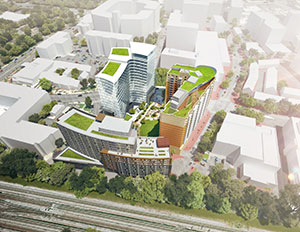by Brianna Crandall — October 28, 2015—Openness, flexibility, safety and comfort are the driving influences behind senior living and medical office concepts of the future, expressed by winning entries of the NAIOP (Commercial Real Estate Development Association) Niche Development design competition. Winning entries were submitted by design firms KGD Architecture, Arlington, VA; Meyer, Ardmore, PA; and Ware Malcomb, Irvine, CA.
In its fourth year, the competition invited architectural firms and design teams who work with developers and owners to conceptualize and design the products in niche development – primarily senior living and medical office/medical. The competition challenged the firms to conceive the opportunities arising from demographic, cultural and political shifts.
While each entry showcased distinctive and abstract design elements, all of them incorporated universal themes of flexibility, practicality and personalization into creating unique spaces that function efficiently and operate sustainably.
“Opportunities in niche development are rising, and it’s fascinating to see how these three companies envision the future,” said Thomas J. Bisacquino, president and CEO of NAIOP. “As progressive thought leaders in commercial real estate development, this year’s winners have showcased cutting-edge, yet practical, concepts.”

KGD Architecture’s Aria redevelops an existing multifamily building into a combination of market-rate and affordable housing, with areas that showcase art and technology uses, as well as medical offices.
KGD Architecture: Aria mixed-income, mixed-use community
KGD Architecture’s concept is Aria, an urban-infill one-million-square-foot development that serves as a multigenerational, mixed-income and mixed-use community. A vibrant one-acre public courtyard at the center of three buildings forms the heart of the project. The concept redevelops an existing multifamily building into a combination of market-rate and affordable housing, with areas that showcase art and technology uses, as well as medical offices.
Sustainable and high-tech elements are employed throughout Aria, from the roof garden terrace, where residents can cultivate herbs, vegetables and fruits, to exterior and interior green walls that help maintain air purity and reduce demand on mechanical HVAC systems. Rooftop photovoltaic panels and microturbines capture solar and wind energy.
Meyer: Continuing care urban community
Meyer offers a continuing care urban community featuring independent living apartments that are located close to the fitness center, the indoor pool and an Amenity Center, which houses a bistro and community room. It redevelops and revitalizes an existing three-story garden apartment complex in an “urban-suburban” location to support lower- and middle-class seniors’ desires to “age in place.”
The reuse of well-located older buildings does not require land development, zoning or municipal approvals, which increases speed to market and reduces development costs. The addition of elevators, active courtyards and community spaces throughout each floor can transform sturdy, older garden apartment complexes into affordable housing for seniors.
Ware Malcomb: Mixed-use medical campus
Ware Malcomb’s mixed-use medical campus includes four primary components: the Mind Nexus, Heart Nexus, Spirit Nexus and Body Nexus. The components can be built using a phased approach and can operate autonomously. The concept’s holistic view of health care delivery envisions “more health, less care,” and brings together a variety of high-tech spaces for learning, healing and wellness in a single destination.
Space needs will shift as patients receive care remotely through technology and less in dedicated medical facilities. Medical professionals will provide virtual consultations to patients through apps and microclinics / kiosks, and storage needs will change, as sterile case goods like stents and tools as well as custom molds and other products are made on-site as needed with 3-D printers.
The design competition presentation is sponsored by CenterPoint Properties, Duke Realty, Geopac, IDI Gazeley, Majestic Realty Co. and The Rockefeller Group. The concepts were presented during NAIOP’s Commercial Real Estate Conference 2015 on October 14 in Toronto.





